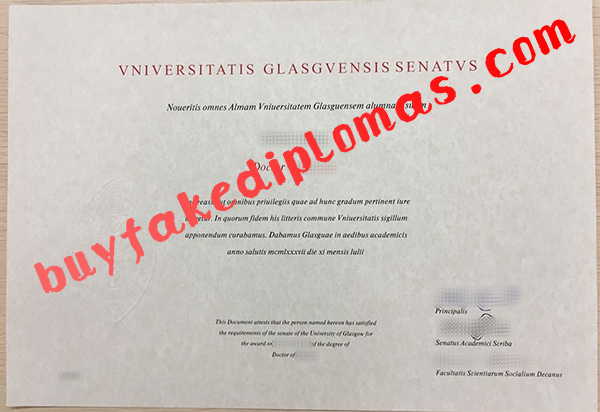We provide the best service at the most favorable price in the market. The original stamps / stickers, perfect and authentic seal and badge samples help you obtain the ideal certificate add our whatsapp: +86 15179517591
Order Fake Vniversitatis Glasgvensis Senatvs Diploma

Vniversitatis Glasgvensis Senatvs Diploma
All degrees, whether bachelor’s, master’s or PhD, are awarded by The University of Glasgow (ranked 65th in the QS World University Rankings 2018) and are accredited by the Ministry of Education in China. Students can rest assured. Latin VNIVERSITATIS GLASGVENSIS SENATVS, fake Vniversitatis Glasgvensis Senatvs Diploma, meaning: Founded in 1845, The Glasgow School of Art is one of the UK’s few independent art schools and has trained many of the world’s most influential artists, designers and architects. GSA Glasgow School of Art’s practical curriculum, which is mostly taught in studios and workshops, attracts talent from all over the world with an interest in visual culture. Many of our students stay in Glasgow after graduation, fake Vniversitatis Glasgvensis Senatvs transcript, thus making the city the birthplace of one of the largest and most vibrant creative communities in the UK. If you are in the field of architecture and decorative arts, you must have heard of Charles Rennie Mackintosh. The main building of Glasgow School of Art was his master’s design. At that time, fake Vniversitatis Glasgvensis Senatvs degree, the master was deeply influenced by Japanese art, and every detail of the architecture was carefully carved, reflecting the simple beauty of Japanese craft. Even one of the chairs in the building is a work of art, and many art lovers visit the building specifically. But in 2014, when a fire broke out in the Mackintosh building, leaving 90% of the main structure and 70% of the interior intact, order fake Vniversitatis Glasgvensis Senatvs Diploma, GSA turned to Page/Park Architects, an experienced architect with close ties to Scottish craftsmen, to rebuild the building. The restoration project is expected to be completed in early 2019.
The University of Glasgow consists of more than 100 departments, which are divided into four schools: the Faculty of Arts, the Faculty of Medicine (including Dentistry), the Faculty of Engineering (Aerospace, Civil Engineering, Electronics and Appliances, Mechanics and Shipbuilding), and the Faculty of Social Sciences (including the Adam Smith Business School). The University’s affiliated institutions include Colechton College in Dunfreth, Glasgow School of Art, Scottish Agricultural College and St Andrews School of Education. The University of Glasgow offers the Scottish International Foundation Programme (pre-university courses). In addition, the University of Glasgow has a research branch in Crichton, Scotland, and the School of Veterinary Medicine of the University of Glasgow is located in Garscube, just four miles away from the university.
The libraries of the University of Glasgow are the pride of the University, with a rich collection of more than 85. The library has more than 2 million volumes and more than 6,000 periodicals, as well as a wide selection of e-books and periodicals. The library is also equipped with Internet facilities for quick access to the library materials of seven other Scottish universities nearby. Open daily from 7 a.m. to 2 a.m., 361 days a year.
The University of Glasgow is located in the city of Glasgow, which is the largest city in Scotland. Glasgow, with a total population of 2.3 million, is located on the west bank of the Clyde River in central Scotland. It is famous for its splendid culture and tradition. Glasgow has its own international airport, and is connected with Europe by convenient road and rail transportation. It’s less than an hour’s drive to the capital, Edinburgh, and tourist attractions such as the Yalxia Coast and Loch Lomond. Glaswegians are hospitable, humorous and old people with a slight accent. Since the establishment of the Cathedral of St Mungo and the University of Glasgow, the city has been developing continuously. In Victorian times, Glasgow was once called the “Second City of the British Empire”. In the 1930s, the Great Depression and two World Wars hit Glasgow hard, and since the 1980s, the rise of the financial industry has made Glasgow recover. The Finniston Crane is the best symbol of Glasgow’s former glory, when it built locomotives for trains all over the world, and when many of the world’s largest ships were built in shipyards on the banks of the Clyde. From the 1950s onwards, the demand for ships fell sharply, leading to a decline in Glasgow’s industry. But today, Glasgow is still the third largest manufacturing city in the UK after London, behind Birmingham and Leeds. The main industrial categories are engineering construction, publishing, food and beverage and clothing. In addition, Glasgow is one of the top 20 financial centres in Europe. In 2012, QS rated the UK as the world’s best student city 4th, the world’s 50th.
